Guinea pigs: feeding and caring at home

Most often, the question of keeping pets arises in families with small children. As a rule, they ask for a kitten or a puppy, but as an alternative, parents offer the child slightly different variants of animals, among which guinea pigs are very popular. These unpretentious animals do not take up much space and do not require much attention. And most importantly, in the process of caring for them, children are instilled with a sense of accuracy and responsibility.

Features of animals
On average, the life expectancy of a guinea pig living at home is 3 years. With maximum care and quality care, its life cycle lasts from 5 to 8 years. In the wild, the animal can easily live for 9 or even 10 years.
Despite the familiar name to everyone, this species of domestic animals cannot swim. When keeping the animal, this factor must be taken into account.



Three species of guinea pigs are known in the zoological field.
- Shorthaired. The length of the hairline over the entire body is no more than 3 cm.
- Long-haired. These animals boast an incredibly long coat that is 15 cm in length throughout the body. On the muzzle, the hair is slightly shorter, the approximate length of the hairs is 7 cm.
- Rare... This type of guinea pig has appeared relatively recently. Their distinctive feature is the absence of hair on the body, except for the head and legs.


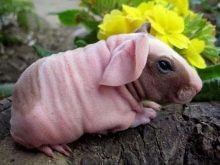
Before you get a guinea pig, you need to familiarize yourself with the habits of this animal. According to its characteristics, the animal belongs to daytime inhabitants, they are active only in the first half of the day. In the morning, the pet eats food, after which it gladly makes contact with its owner. At lunchtime and in the evening, the activity of the animals decreases markedly. At night, the animal sleeps.
When purchasing several guinea pigs at once, it is important that they live together in the same territory until the moment of purchase.... Otherwise, conflicts may arise between unfamiliar animals. Of course, their fights proceed without bloodshed.
The most that the warring parties are capable of is trying to scare the opponent with their movements. It is very interesting to watch this process. The two conflicting parties stand opposite each other, raise their heads high and begin to gnash their teeth. The time of "military action" is unlimited, but in the end the weak animal will retreat. Quite serious conflicts arise between males sharing a territory or a female.
If from early childhood guinea pigs were brought up together, their mood will always be friendly and will not lead to fights.


When guinea pigs are kept in large numbers, you can see how vividly the herd feeling is expressed in this species of animals. Each individual male constantly has several groups of females. They do not like strangers and drive them away very quickly.
Guinea pigs, by their nature, are indifferent to other pets. It is enough for them to communicate with their team. Unfortunately, this fact can play a bad role in the life of a rodent, especially if other species of animals live in the house. For example, having met a cat, a frightened animal will try to hide in the darkest corner and bury itself underground. And realizing that it will not be possible to escape, he presses himself against the wall and freezes in one position. In this case, the guinea pig can get a heart attack.

By their nature, guinea pigs are similar to many types of pets in that they engage in coprophagia, that is, they eat their feces. The only explanation for this fact lies in the need for the animal's body to take important trace elements and vitamins that have not been assimilated the first time.
Many parents worry that a guinea pig might bite their child. This is only possible if the child is careless with the animal. In fact, guinea pigs are very friendly to their owner. They allow you to stroke your face, knock on your nose.
But as stated earlier, they can “turn on” a little aggression by showing dissatisfaction with their actions. For example, if an animal is uncomfortably grabbed, it begins to push the person's hand away with its head, after which the legs will be used. If the owner does not react in any way to the animal's demands to let him go, the guinea pig begins to snap its teeth. Only after the last hint can she lightly bite her finger. Thus, rodents report that they are tired of the manifestations of human feelings.

When caring for a guinea pig, it is important to understand the language of the animal. If she begins to lightly bite the skin of her fingers, then she asks to return to the cage.
At the same time, it is strictly forbidden to beat animals. Otherwise, she may get scared and lose confidence in her owner.

Pros and cons of content
Before adopting a pet, each person weighs the pros and cons of caring for a pet. This applies not only to dogs and cats, but also to small rodents, including guinea pigs. First, you should consider the list of advantages in keeping this species of rodents.
- Guinea pigs will become good friends for the little owner. Firstly, they do not take up much space, and secondly, the child develops a sense of responsibility.
- By their nature, guinea pigs adapt very easily and quickly to a new habitat.In a short period of time, they get used to the new nickname and begin to respond to the conditioned signal of the owner.
- Guinea pigs are non-aggressive animals. Only with light snacks do they show that something is not to their liking.
- These rodents are oblivious to other pets.
- Guinea pigs are picky about their diet. There is no need to purchase special delicacies or prepare gourmet meals to feed them.
- Unlike dogs, which many children dream about, guinea pigs do not need to be walked. In addition, these rodents do not need physical activity.
- It is this type of rodent that is considered the most hypoallergenic domestic animal.

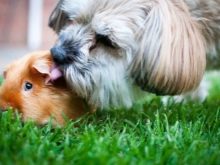

Having familiarized yourself with the positive aspects of keeping guinea pigs, you should also study the negative aspects.
- Guinea pigs are not always trainable. But even the most capricious individuals can learn a few tricks.
- Quite often, they can be intrusive. This is how the pigs beg for food and attention.
- Guinea pigs are quite noisy. They can make many different sounds throughout the day, such as whistling, squealing or grunting. Moreover, each individual sound emitted by the animal has a specific meaning.
- The animals are very active in the morning. They are ready to scatter sawdust and food around the cage, which will have to be cleaned daily.
- When letting a guinea pig go for a walk, the owners need to be prepared for gnawed wires, furniture and other things.
- While walking around the apartment, the guinea pig can relieve itself anywhere.
- Guinea pigs are afraid of cold and extreme heat and can catch a cold even with a slight draft.
- By their nature, sea rodents are herd animals. They do not tolerate solitude, therefore they require several relatives nearby.
- These are very shy rodents. With frequent fears from their owner, they can lose confidence in him.

Suitable dwelling
Most of their time, rodents living at home are on their own territory, where they experience a sense of comfort and safety. It is advisable for them to purchase a separate dwelling.
- Cell. The most common option for guinea pig housing. The selected cage should be spacious in size. The pallet of the rodent's dwelling must be made of plastic. The bottom of the dwelling should not have a lattice base, the small foot of the animal can fall into the slot, which will cause the animal to be damaged. When choosing a home, there is no need to buy two-story models. Guinea pigs do not jump or climb. Even if the animal manages to climb onto the second tier, it will no longer be able to descend. Jumping off can damage the foot. Thanks to the lattice walls, the cage is ideally ventilated. Separate locks on the doors prevent the rodent from getting out.
The only drawback is the daily cleaning of the area around the cage, as the guinea pigs throw sawdust, food and debris through the grates.


- Terrarium. Quite a good option for keeping a guinea pig. The main thing is that the sides of the container are made of metal mesh, not glass. An important advantage of the terrarium is the absence of litter around. It is strictly forbidden to use a terrarium made entirely of glass. In them, the animal will be uncomfortable due to insufficient oxygen circulation, and the litter at the bottom will be constantly wet.

- Aviary. Some apartment owners who are allowed living space prefer to use this option for a rodent house. The main thing is that the height of the walls is at least 40 cm, otherwise the guinea pig will easily get out for a walk.
It is important to remember that this kind of housing is not suitable for homes where cats or dogs live in addition to a rodent.

- Dune. It is used quite rarely as a home for rodents, mainly used for their transportation.Zoologists also do not recommend using such containers for keeping small animals. The dunes are very small and cramped in size. The air inside is very limited, which makes rodents feel uncomfortable.

Where to place?
After purchasing a guinea pig home, it is very important to determine the right place for it. It should be light, because it is very important for the guinea pig to get enough light. But in natural light, it's important to remember that guinea pigs do not tolerate direct sunlight, especially during the warm season.
In winter, it is strictly forbidden to place the rodent's dwellings near the battery. Guinea pigs are very sensitive to hypothermia and drafts, so their homes should not be placed at the front door and in ventilated areas.
So that the rodent is not bored, his dwelling must be located in the room where people are most often found. If noisy evenings take place in the room, it is necessary to put a decorative box with a roof in the rodent's cage, where the animal can hide and take a breath.



How to equip?
Quite often, when purchasing a home for a small rodent, sales consultants offer to purchase a number of additional accessories, which, in their words, are extremely necessary for the animal. It will be difficult for a novice owner to navigate on the spot in the need for this or that thing, so they can purchase completely useless goods. To create the necessary coziness and comfort for the animal, you need to purchase only a few things.
- Feeder. Store shelves are lined with floor-standing and hanging models of food tanks. Guinea pigs should choose hanging containers.
- Sennitsa. Hay is the staple food of small rodents, and it must be stored in a separate container, rather than scattered along the bottom of the home.
- Drinking bowl. Hanging models will be the most suitable option, otherwise the whole bottom of the cage will be wet, and the animal will be wet.
- Decorative house. The guinea pig, like any other pet, needs to have a secluded place where it can hide and rest from undue attention.



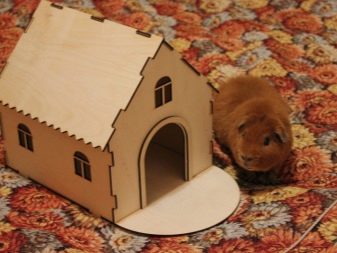
In addition to the elements, without which the guinea pig will not be able to live, an additional range of accessories is supposed to allow the animal to train or just play:
- cubes and balls;
- tunnels and shelters;
- hanging hammock;
- sunbed;
- salt stone.






It is strictly forbidden to install a running wheel in the cage and purchase a walking ball.
Guinea pigs, by their very nature, are not adapted to move around in these accessories; when using them, they can fracture their legs and even injure the spine.
Feeding rules
Good care for guinea pigs is largely dependent on their nutrition. Unfortunately, inexperienced owners pay too little attention to this issue. Therefore, only dry food for rodents is purchased, assuming that the elements contained in it are ideal for the guinea pig. Only few people know that these adorable animals prefer to feed on hay.
Next, it is suggested that you familiarize yourself with the main foods that should be in the diet of guinea pigs.
- Hay.
- Green herbs - dandelions, nettles, burdock, lettuce and chamomile.
- Fresh vegetables... Guinea pigs are very fond of pumpkin and squash. They do not mind eating carrots, cucumbers, beets and tomatoes.
- Small twigs. Better to choose bushes of raspberries and blueberries. Apple and pear twigs will become a special delicacy for this rodent.
- Berries and fruits, but exceptionally fresh. For example, bananas, cherries, strawberries, apples.






Upon a detailed examination of dry food for rodents, experts have not been able to determine its usefulness for guinea pigs, although many owners include this feeding in the animal's diet. The main thing is to remember that dry food is quite high in calories, and with its frequent use, guinea pigs begin to gain weight, which negatively affects their health. The animals themselves will not be able to lose weight on their own, as they lead a sedentary lifestyle.
If you wish, pamper the little rodent with a delicacy you can give him nuts, but no more than three times a week.
It is strictly forbidden to give your guinea pigs pasta, dairy products, fish, sausages, potatoes, sweets, pastries, eggs and mushrooms.

The feeding procedure itself also has certain rules.
- In no case should the animal be left without food. If the rodent remains hungry for 20 hours, irreversible processes begin to occur in its body, which can lead to the death of the animal.
- Fresh hay should always be in a specific location in the cage. If it ends, you need to put a small bunch.
- Vegetables and fruits are given to the animal no more than twice a day.
- The diet of a guinea pig, like that of any animal, should be varied. Therefore, it is recommended to alternate between different types of vegetables in his menu.
- In winter, due to the lack of fresh grass, the guinea pig needs to consume cereals.
- Guinea pigs should not be overfeeded. Their daily rate is 30% of their own weight.
- The introduction of new products into the diet must be done gradually, constantly monitoring the condition of the animal.
- Guinea pigs consume little water. But, despite this, the liquid in the drinking container must always be cleaned and boiled.

Hygiene and bathing
The main part of caring for your guinea pig is brushing the coat on a daily basis. This procedure allows you to keep the hair of the animal clean. It is enough to wipe the soiled paws with a damp cloth. It is also necessary to carry out daily cleaning inside the rodent's house, to get rid of uneaten food.
Bathing your guinea pig is necessary only in the most extreme cases. Water procedures cause great stress in the animal. But if you still have to resort to them, it is important that the water in the bathing tank is warm. And the procedure itself should be carried out in a heated room, where there are no drafts. Use a shampoo for cats and dogs as a cleanser. For bathing, use a small container with a minimum amount of water.
It is impossible for extraneous noises to arise during the bathing process, otherwise the animal may be frightened and scratch the owner.

After washing, the animal should be wrapped in a soft towel and held on your hands until the coat is completely dry. It is strictly forbidden to use a hair dryer, as the loud sound can scare a helpless rodent.
It is important for novice breeders to remember that It is strictly forbidden to bathe guinea pigs under one year of age. Their fragile body may not withstand this procedure.

Diseases and vaccinations
Proper maintenance of guinea pigs at home helps to avoid various diseases. If suddenly the care does not meet the required standards, the animal may face digestive problems and colds. Further, it is proposed to familiarize yourself with the symptoms of the development of ailments:
- intense thirst;
- stuck wool;
- cough and shortness of breath;
- lethargic state, long lying with closed eyes;
- the appearance of parasites in the coat;
- sores on the skin;
- loose stools.
At the first signs, the guinea pig should be shown to a doctor.
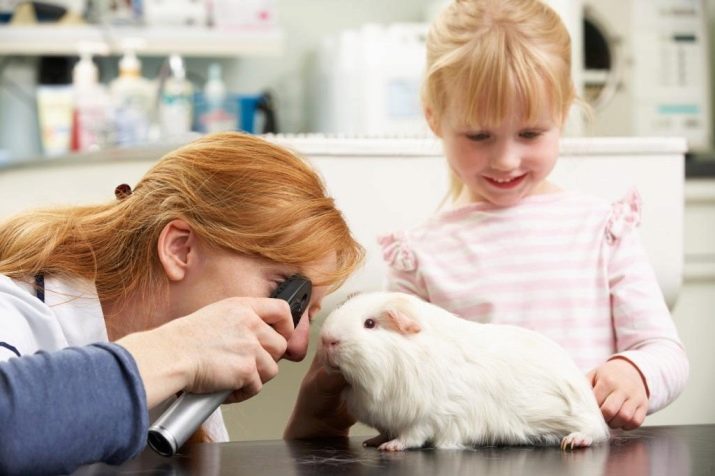
Based on the knowledge and experience of breeding dogs and cats, aspiring rodent breeders are wondering about the need to vaccinate the mumps. Guinea pigs are not actually vaccinated. Only in some cases can veterinarians offer to vaccinate the animal against bordeteddiosis. Vaccination does not protect the rodent from infection, but mitigates the disease process itself.
It is important to know that when buying a new guinea pig, it is necessary to place it in a quarantine zone for several weeks, and only then transfer the animal to a common cage with other pets.

Training and games
Do not believe the argument that guinea pigs are boring rodents who only know how to eat and sleep. In fact, they are quite active and ready to play with their master. By their nature, these rodents are quite intelligent, they can easily learn to do different tricks.
Before starting to actively engage with a guinea pig, it is necessary that she gets used to the new owner, begins to trust him. To do this, the owner will need to devote a lot of time to the little pet so that he begins to trust the owner.
- For several days, the owner of the animal should calmly approach the cage with the guinea pig and talk to her affectionately, thanks to which the animal will begin to get used to his voice.
- The next stage of taming is a treat from your hand. If a guinea pig begins to trust a person, she calmly approaches him and takes food. The main thing is not to make sudden movements at this moment. After a few days, the rodent itself will start running up to its owner and check if he has brought a tasty treat.
- After the first two steps, the owner can try to get the guinea pig out of the cage and hold it in their arms for a while. If the animal is frightened, it is enough to pat it on the back, while gently talking to it. After the rodent is convinced that there is no danger, he will relax and enjoy contact with a person.

It is very interesting to play with a guinea pig. Having fun is a lot like the development of toddlers. The animal with great pleasure will get the pieces of delicacy hidden in different parts of the cage. A ball made of rustling paper will attract the attention of a rodent, making it possible to play a kind of football with it.
Having felt the friendly connection between the guinea pig and its owner, you can start training the animal. As a reward, like any other animal, it is suggested to give a favorite treat.
With the right approach, it will turn out to teach the guinea pig to respond to its name, as well as to roll over from side to side.



Useful Tips
Many people, deciding to have a guinea pig, assume that the rodent does not require special care. But, despite this, it requires a certain amount of care, warmth and attention, which should be provided as much as possible by the owner. The novice owner needs to know a few basic rules, thanks to which the guinea pig can feel cozy, comfortable and safe.
- Before purchasing a home for an animal, it is necessary to determine its permanent location in the house.
- If other types of pets live in the house, you should carefully consider the choice of a home for a rodent. Aviaries and terrariums immediately move aside.
- It is important for novice breeders to remember that guinea pigs prefer room temperature, they do not like abundant heat and severe frosts.
- Keeping a guinea pig correctly is difficult. In order to stay on track, it is best to schedule an hourly schedule for caring for her.
- By nature, guinea pigs are herd rodents. They don't like being alone. Therefore, it is best to acquire several congeners at once. Of course, you can start with one individual, but the internal state of the rodent will significantly improve when you see a fellow next to you.
- Guinea pigs feel extremely easy and free at home, but their space should not be limited to only a cage. The rodent needs daily walks around the room.
- While walking the guinea pig, the owner needs to closely monitor the animal, otherwise it may be frightened by harsh sounds and even get hurt.
- You need to take care of the guinea pig every day - comb the coat, clean the territory of the animal and be sure to feed it with fresh food.
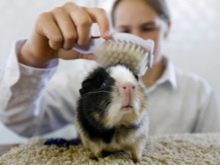


More information about guinea pigs awaits you in the video below.








